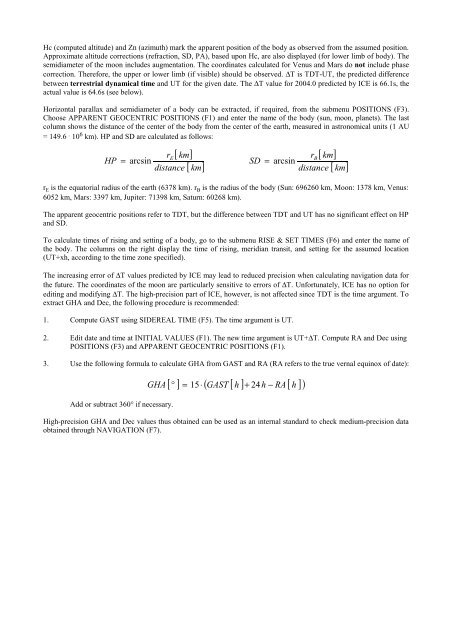The Geographic Position of a Celestial Body
The Geographic Position of a Celestial Body
The Geographic Position of a Celestial Body
Create successful ePaper yourself
Turn your PDF publications into a flip-book with our unique Google optimized e-Paper software.
Hc (computed altitude) and Zn (azimuth) mark the apparent position <strong>of</strong> the body as observed from the assumed position.<br />
Approximate altitude corrections (refraction, SD, PA), based upon Hc, are also displayed (for lower limb <strong>of</strong> body). <strong>The</strong><br />
semidiameter <strong>of</strong> the moon includes augmentation. <strong>The</strong> coordinates calculated for Venus and Mars do not include phase<br />
correction. <strong>The</strong>refore, the upper or lower limb (if visible) should be observed. ΔT is TDT-UT, the predicted difference<br />
between terrestrial dynamical time and UT for the given date. <strong>The</strong> ΔT value for 2004.0 predicted by ICE is 66.1s, the<br />
actual value is 64.6s (see below).<br />
Horizontal parallax and semidiameter <strong>of</strong> a body can be extracted, if required, from the submenu POSITIONS (F3).<br />
Choose APPARENT GEOCENTRIC POSITIONS (F1) and enter the name <strong>of</strong> the body (sun, moon, planets). <strong>The</strong> last<br />
column shows the distance <strong>of</strong> the center <strong>of</strong> the body from the center <strong>of</strong> the earth, measured in astronomical units (1 AU<br />
= 149.6 . 10 6 km). HP and SD are calculated as follows:<br />
HP<br />
r E is the equatorial radius <strong>of</strong> the earth (6378 km). r B is the radius <strong>of</strong> the body (Sun: 696260 km, Moon: 1378 km, Venus:<br />
6052 km, Mars: 3397 km, Jupiter: 71398 km, Saturn: 60268 km).<br />
<strong>The</strong> apparent geocentric positions refer to TDT, but the difference between TDT and UT has no significant effect on HP<br />
and SD.<br />
To calculate times <strong>of</strong> rising and setting <strong>of</strong> a body, go to the submenu RISE & SET TIMES (F6) and enter the name <strong>of</strong><br />
the body. <strong>The</strong> columns on the right display the time <strong>of</strong> rising, meridian transit, and setting for the assumed location<br />
(UT+xh, according to the time zone specified).<br />
<strong>The</strong> increasing error <strong>of</strong> ΔT values predicted by ICE may lead to reduced precision when calculating navigation data for<br />
the future. <strong>The</strong> coordinates <strong>of</strong> the moon are particularly sensitive to errors <strong>of</strong> ΔT. Unfortunately, ICE has no option for<br />
editing and modifying ΔT. <strong>The</strong> high-precision part <strong>of</strong> ICE, however, is not affected since TDT is the time argument. To<br />
extract GHA and Dec, the following procedure is recommended:<br />
1. Compute GAST using SIDEREAL TIME (F5). <strong>The</strong> time argument is UT.<br />
2. Edit date and time at INITIAL VALUES (F1). <strong>The</strong> new time argument is UT+ΔT. Compute RA and Dec using<br />
POSITIONS (F3) and APPARENT GEOCENTRIC POSITIONS (F1).<br />
3. Use the following formula to calculate GHA from GAST and RA (RA refers to the true vernal equinox <strong>of</strong> date):<br />
Add or subtract 360° if necessary.<br />
[ km]<br />
[ km]<br />
rE<br />
rB<br />
= arcsin SD = arcsin<br />
distance<br />
distance<br />
[ ° ] = 15⋅<br />
( GAST [ h ] + 24h<br />
RA [ h ] )<br />
GHA −<br />
[ km]<br />
[ km]<br />
High-precision GHA and Dec values thus obtained can be used as an internal standard to check medium-precision data<br />
obtained through NAVIGATION (F7).








